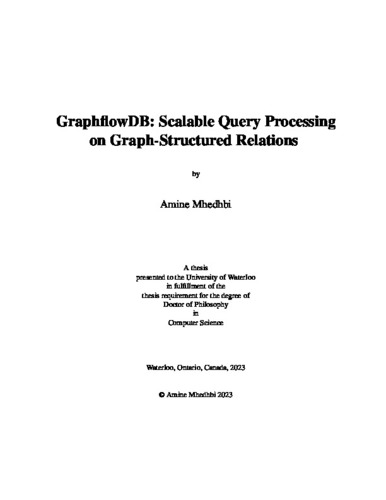| dc.description.abstract | Finding patterns over graph-structured datasets is ubiquitous and integral to a wide range of analytical applications, e.g., recommendation and fraud detection. When expressed in the high-level query languages of database management systems (DBMSs), these patterns correspond to many-to-many join computations, which generate very large intermediate relations during query processing and degrade the performance of existing systems.
This thesis argues that modern query processors need to adopt two novel techniques to be efficient on growing many-to-many joins: (i) worst-case optimal join algorithms; and (ii) factorized representations. Traditional query processors generate join plans that use binary joins, which in iteration take two relations, base or intermediate, to join and produce a new relation. The theory of worst-case optimal joins have shown that this style of join processing can be provably suboptimal and hence generate unnecessarily large intermediate results. This can be avoided on cyclic join queries if the join is performed in a multi-way fashion a join-attribute-at-a-time. As its first contribution, this thesis proposes the design and implementation of a query processor and optimizer that can generate plans that mix worst-case optimal joins, i.e., attribute-at-a-time joins and binary joins, i.e., table-at-a-time joins. In contrast to prior approaches with novel join optimizers that require solving hard computational problems, such as computing low-width hypertree decompositions of queries, our join optimizer is cost-based and uses a traditional dynamic programming approach with a new cost metric.
On acyclic queries, or acyclic parts of queries, sometimes the generation of large intermediate results cannot be avoided. Yet, the theory of factorization has shown that often such intermediate results can be highly compressible if they contain multi-valued dependencies between join attributes. Factorization proposes two relation representation schemes, called f- and d-representations, to represent the large intermediate results generated under many-to-many joins in a compressed format. Existing proposals to adopt factorized representations require designing processing on fully materialized general tries and novel operators that operate on entire tries, which are not easy to adopt in existing systems. As a second contribution, we describe the implementation of a novel query processing approach we call factorized vector execution that adopts f-representations. Factorized vector execution extends the traditional vectorized query processors to use multiple blocks of vectors instead of a single block allowing us to factorize intermediate results and delay or even avoid Cartesian products. Importantly, our design ensures that every core operator in the system still performs computations on vectors. As a third contribution, we further describe how to extend our factorized vector execution model with novel operators to adopt d-representations, which extend f-representations with cached and reused sub-relations. Our design here is based on using nested hash tables that can point to sub-relations instead of copying them and on directed acyclic graph-based query plans.
All of our techniques are implemented in the GraphflowDB system, which was developed throughout the years to facilitate the research in this thesis. We demonstrate that GraphflowDB’s query processor can outperform existing approaches and systems by orders of magnitude on both micro-benchmarks and end-to-end benchmarks. The designs proposed in this thesis adopt common-wisdom query processing techniques of pipelining, vector-based execution, and morsel-driven parallelism to ensure easy adoption in existing systems. We believe the design can serve as a blueprint for how to adopt these techniques in existing DBMSs to make them more efficient on workloads with many-to-many joins. | en |

